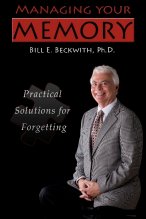Memory Has Many Faces
There are many types of learning and memory. There is associative learning such as that involved in knowing that a red traffic light means stop and a green traffic light means go. There is nonassociative learning where learning and memory interact to allow us to “learn to learn.” The more crossword puzzles we do the better we become at crossword puzzles. There is perceptual learning. I often marvel at how well artists can learn to use space and design to create beautiful images. There is motor learning which allows us to be able to learn to swim or ride a bicycle.
There are also many learning styles or types of intelligence. Some are best as visual learners. They need to see in pictures or images. They best learn and remember a new name by seeing it. Some are best as auditory learners. They learn and remember by hearing a lecture or a speech. They learn and remember a new word by hearing it spoken aloud. Some are tactile or kinesthetic learners and learn best by doing. They learn and remember a new word best by writing it down. Further, learning styles may include spatial learners (good navigators), linguistic learners (good at learning languages), musical learners (musicians), and naturalists among others. Of course, the best approach to learning and remembering is to learn by several of these methods.
The neurobiology of learning memory has advanced greatly during my career. During the first 20 years of my career as a researcher and educator, I was interested in understanding and applying principles of how the brain learns and remembers to students with normal memory. The past 20 years of my career have been dedicated to understanding and using this knowledge for those like me who are getting older and those with progressively failing memory. Clearly we owe it to those who are showing declining memory to identify which strengths and learning styles continue to work. We focus so much on assessing for deficits that we neglect retained strengths. If we are going to build a quality of life for those with declining memory, we must build it around strengths and styles. We must focus more on productivity than competency. Just as when we learn something new, we must incorporate the following into a memory plan.
• Repeat –reinforce memory by repetition. Constancy and routine are essential for those with memory loss.
• Reward – we remember best when memory is associated with reward. A smile goes a long way.
• Actively engage in the world – activities must focus on doing and participation not on remembering. Listening to music, gardening, talking about children or work, and going to lunch reinforces memories in these areas.
• Manage stress – build and model calmness into activities. Touch and soothing environments help memory work better.
• Manage fatigue – do more challenging things in the morning when rested and take breaks. Do more routine things latter in the day that require less thinking than doing.
• Reduce the need for multitasking – do one thing or one step at a time.




